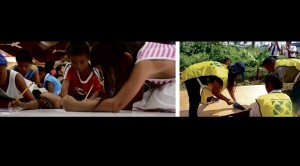
CHURCH of Jesus Christ of Latter-day Saints allotted $1.4 million for basic needs right after Supertyphoon “Yolanda.”
After Super Typhoon “Yolanda” hit the Visayas, the country received an enormous amount of support from different parts of the world. Filipinos were moved by this generosity and thanked those who helped in any way they can.
For their part, members of the Church of Jesus Christ of Latter Day Saints (LDS, or also known as Mormons) immediately sent food and hygiene kits to church members in affected areas. They worked closely with the local government and other organizations in the assessment of the situation and distribution of relief goods.
The church also extended help to non-members through LDS Charities.
The LDS Charities manages the humanitarian aspect of the church and all of the members around the world are involved, one-way or the other.
Sister Linda Burton, president of Relief Society General Presidency of the LDS says, “The church is trying to do what it did in Haiti years ago (and until now) by teaching people self-reliance. To achieve that, we try to help people find education that will lead to a job.”
She, however, notes that Filipinos are quick to “recover” from the tragedy compared to other disaster-stricken areas the church has visited and helped.
But before setting up the livelihood programs, they first need to build shelters. At present, the group has built more than 1,000 shelters. Their aim is 3,000 by the end of May.
“Right after the typhoon hit, we allotted $1.4 million for basic needs such as food, water and hygiene kits,” says Brent Nielson, of LDS Philippines Area Presidency. “Once everything calmed down a little bit, we assessed the needs of our members and found out that 3,000 families were homeless. That’s when we decided to help begin building shelters.”
The group already started teaching the idea of self-reliance by involving them in shelter building. The church provided construction materials and tools while families helped in building them.
Haidi Fajardo, area director of Public Affairs of LDS in the Philippines, says the church has been providing training to its members and non-members as part of its humanitarian services. Its Self-Reliance Centers train people basic skills like how to answer interview questions or how to start a small business.
Humanitarian
Humanitarian efforts are very much a part of growing up as member of LDS. From the moment members can interact with others, they are taught to look after each other.
Humanitarian service may include emergency response to natural disasters, such as an earthquake or a tsunami, or man-made disasters, such as the effects of war and famine. It may also be part of a longer-term effort to meet serious and more entrenched human needs, such as the need to alleviate diseases.
Nielson relates how they helped the Japanese people in Sendai after the tsunami. Like in the Philippines, after the church provided immediate basic needs, they assessed what would they need to go on with their life.
“We provided them with boats for their livelihood,” Nielson says.
In the Philippines, the survivors of Supertyphoon “Yolanda” are not the only recipients of these humanitarian efforts.
“In Biliran, Leyte, the church provided more than 12 million water projects,” Fajardo says.
Again, it attached self-reliance into the project by providing the materials and letting the proper government agencies implement the project.
“We (also) donated 2,000 shelter kits to Ormoc,” she adds.
Nielson says that by working with the local government and the social welfare department very closely, they could easily identify the kind of help needed. The church is experienced in responding to these types of aftermath as its humanitarian works are all over the world.
When they have built the shelters, they will then assess how else they can assist the church members and non-members go back to their normal life.
The Church of Jesus Christ Latter-day Saints was founded in 1898 in Utah. It was established in the Philippines in 1961 but two of its members who were also American soldiers had already been preaching since World War II. They ceased the missions when they went back home.
The church now has 15 million members worldwide with 675,166 from the Philippines.